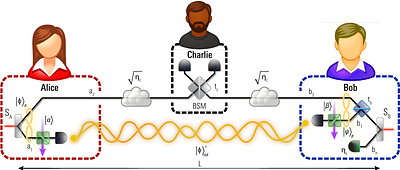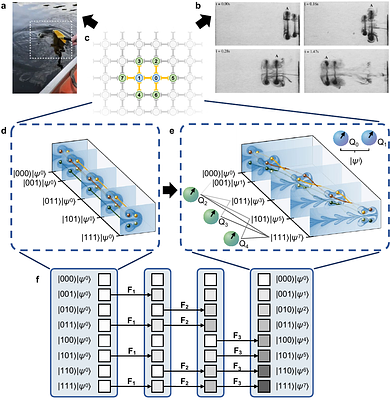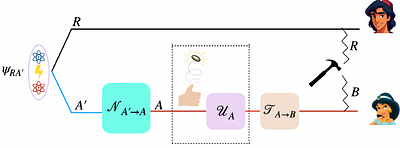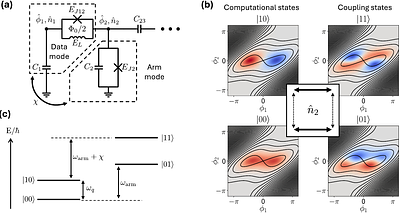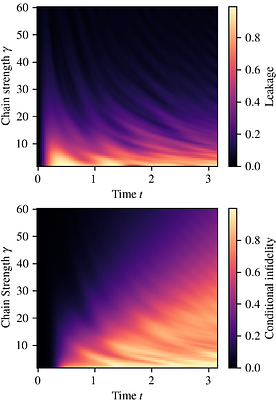By: Jamil Assaad, Rodrigo Panosso Macedo
We revisit the computation of quasinormal modes (QNMs) of the Kerr black hole using a numerical approach exploiting a representation of the Teukolsky equation as a $2D$ elliptic partial differential equation. By combining the hyperboloidal framework with a $m$-mode decomposition, we recast the QNM problem into a genuine eigenvalue problem for each azimuthal mode. This formulation enables the simultaneous extraction of multiple QNMs, tradition... more
We revisit the computation of quasinormal modes (QNMs) of the Kerr black hole using a numerical approach exploiting a representation of the Teukolsky equation as a $2D$ elliptic partial differential equation. By combining the hyperboloidal framework with a $m$-mode decomposition, we recast the QNM problem into a genuine eigenvalue problem for each azimuthal mode. This formulation enables the simultaneous extraction of multiple QNMs, traditionally labelled by overtone number $n$ and angular index $\ell$, without requiring prior assumptions about their structure. We advocate for a simplified notation in which each overtone is uniquely labelled by a single index $q$, thereby avoiding the conventional but artificial distinction between regular and mirror modes. We compare two distinct hyperboloidal gauges-radial fixing and Cauchy horizon fixing-and demonstrate that, despite their different geometric properties and behaviour in the extremal limit, they yield numerical values for the QNM spectra with comparable accuracy and exponential convergence. Moreover, we show that strong gradients observed near the horizon in the extremal Kerr regime are coordinate artefacts of specific slicing rather than physical features. Finally, we investigate the angular structure of the QNM eigenfunctions and show that the $m$-mode approach allows flexible projection onto both spin-weighted spheroidal and spherical harmonic bases. These results underscore the robustness and versatility of the hyperboloidal $m$-mode method as a foundation for future studies of QNM stability, pseudospectra, and mode excitation in gravitational wave astronomy. less
By: Yazeed K. Alwehaibi, Ewan Mer, Gerard J. Machado, Shang Yu, Ian A. Walmsley, Raj B. Patel
Certifying genuine nonclassical correlations over long distances is crucial for device-independent (DI) quantum information protocols. However, in photonic platforms this remains technologically challenging due to photon loss, which opens the detection-loophole, rendering violations increasingly difficult for less efficient detectors. A well-known strategy to mitigate this involves using non-maximally entangled states, which Eberhard showed c... more
Certifying genuine nonclassical correlations over long distances is crucial for device-independent (DI) quantum information protocols. However, in photonic platforms this remains technologically challenging due to photon loss, which opens the detection-loophole, rendering violations increasingly difficult for less efficient detectors. A well-known strategy to mitigate this involves using non-maximally entangled states, which Eberhard showed can tolerate lower detection efficiencies. However, existing proposals and demonstrations have been limited to short distances, as their success rates scale linearly with channel transmittance. Here, we propose a protocol to herald a tunable entangled state between distant users that achieves a post-selection-free Bell inequality violation at the Eberhard limit. We identify the loss independence of the vacuum component amplitude of the prepared state as the source of this enhancement. Notably, our scheme requires only quantum interference at a central station, followed by the detection of a single photon, preserving the optimal square-root scaling with channel transmittance. Our approach provides greater loss-tolerance in entanglement distribution, bringing long-distance DI applications closer to practical implementation. less
By: Tharaka Alapati, S. Shankaranarayanan
We compute the quasi-normal mode (QNM) frequencies of slowly rotating black holes in dynamical Chern-Simons (dCS) gravity, including corrections up to second order in the black hole's dimensionless spin parameter ($\chi$) and second order in the dCS coupling parameter ($\alpha$). Due to the complexities of constructing a Newman-Penrose tetrad at this order, we employ a metric perturbation approach. We derive a system of coupled ordinary diffe... more
We compute the quasi-normal mode (QNM) frequencies of slowly rotating black holes in dynamical Chern-Simons (dCS) gravity, including corrections up to second order in the black hole's dimensionless spin parameter ($\chi$) and second order in the dCS coupling parameter ($\alpha$). Due to the complexities of constructing a Newman-Penrose tetrad at this order, we employ a metric perturbation approach. We derive a system of coupled ordinary differential equations for the primary axial $l$-mode and the polar $l\pm 1$ modes, which is then solved numerically with appropriate ingoing and outgoing wave boundary conditions. Our numerical framework is validated in the General Relativistic limit against known Schwarzschild QNMs and highly accurate Kerr QNM results for $\chi \leq 0.15$. For the fundamental $n=0, l=m=2$ axial mode, we present detailed numerical results illustrating the dependence of QNM frequencies on both $\chi$ and $\alpha$. We observe that while rotation generally increases the damping time, increasing the dCS coupling parameter significantly reduces the damping time of the axial mode. This finding contrasts with previous analytical work on polar modes, which suggested an increase in damping time due to dCS effects, highlighting a crucial parity-dependent difference in how dCS gravity impacts black hole ringdowns. Furthermore, we provide an analytical fitting formula for this mode. These results, incorporating coupled spin and dCS effects at second order, provide more accurate theoretical predictions for testing dCS gravity with gravitational wave observations of black hole ringdowns. The refined QNM calculations are particularly relevant for lower-mass black hole merger events, such as GW230529, where dCS corrections may be more prominent and their distinct damping signatures could be observable. [Abridged Version] less
By: Ziteng Wang, Jiarun Zhong, Ke Wang, Zitian Zhu, Zehang Bao, Chenjia Zhu, Wenwen Zhao, Yaomin Zhao, Yue Yang, Chao Song, Shiying Xiong
Vortex interactions are commonly observed in atmospheric turbulence, plasma dynamics, and collective behaviors in biological systems. However, accurately simulating these complex interactions is highly challenging due to the need to capture fine-scale details over extended timescales, which places computational burdens on traditional methods. In this study, we introduce a quantum vortex method, reformulating the Navier--Stokes (NS) equations ... more
Vortex interactions are commonly observed in atmospheric turbulence, plasma dynamics, and collective behaviors in biological systems. However, accurately simulating these complex interactions is highly challenging due to the need to capture fine-scale details over extended timescales, which places computational burdens on traditional methods. In this study, we introduce a quantum vortex method, reformulating the Navier--Stokes (NS) equations within a quantum mechanical framework to enable the simulation of multi-vortex interactions on a quantum computer. We construct the effective Hamiltonian for the vortex system and implement a spatiotemporal evolution circuit to simulate its dynamics over prolonged periods. By leveraging eight qubits on a superconducting quantum processor with gate fidelities of 99.97\% for single-qubit gates and 99.76\% for two-qubit gates, we successfully reproduce natural vortex interactions. This method bridges classical fluid dynamics and quantum computing, offering a novel computational platform for studying vortex dynamics. Our results demonstrate the potential of quantum computing to tackle longstanding challenges in fluid dynamics and broaden applications across both natural and engineering systems. less
By: Himanshu Badhani, Dhanuja G S, Swati Choudhary, Vishal Anand, Siddhartha Das
The erasure of information is fundamentally an irreversible logical operation, carrying profound consequences for the energetics of computation and information processing. In this work, we investigate the thermodynamic costs associated with erasing (and preparing) quantum processes. Specifically, we analyze an arbitrary bipartite unitary gate acting on logical and ancillary input-output systems, where the ancillary input is always initialized... more
The erasure of information is fundamentally an irreversible logical operation, carrying profound consequences for the energetics of computation and information processing. In this work, we investigate the thermodynamic costs associated with erasing (and preparing) quantum processes. Specifically, we analyze an arbitrary bipartite unitary gate acting on logical and ancillary input-output systems, where the ancillary input is always initialized in the ground state. We focus on the adversarial erasure cost of the reduced dynamics~\textemdash~that is, the minimal thermodynamic work required to erase the logical output of the gate for any logical input, assuming full access to the ancilla but no access to any purifying reference of the logical input state. We determine that this adversarial erasure cost is directly proportional to the negative min-entropy of the reduced dynamics, thereby giving the dynamical min-entropy a clear operational meaning. A key foundation of this result is the quantum process decoupling theorem, which quantitatively relates the decoupling ability of a process with its min-entropy. This insight bridges thermodynamics, information theory, and the fundamental limits of quantum computation. less
By: Jeremy B. Kline, Alec Yen, Stanley Chen, Kevin P. O'Brien
We present a superconducting qubit which consists of two strongly coupled modes: one for data storage and one for coupling, allowing faster, higher-fidelity entangling gates and readout. The use of a dedicated coupling mode allows nonlinear couplings of several hundred MHz between the data mode and other elements, with minimal linear coupling to the data mode. Including decoherence, simulations show that this architecture enables microwave-on... more
We present a superconducting qubit which consists of two strongly coupled modes: one for data storage and one for coupling, allowing faster, higher-fidelity entangling gates and readout. The use of a dedicated coupling mode allows nonlinear couplings of several hundred MHz between the data mode and other elements, with minimal linear coupling to the data mode. Including decoherence, simulations show that this architecture enables microwave-only CZ gates with an infidelity of $8.6\times10^{-5}$ in 17 ns and always-on ZZ interaction less than 0.4 kHz. Numerical simulations also show readout with state assignment error of $1\times10^{-4}$ in 27 ns (assuming quantum efficiency $\eta=0.5$), Purcell-limited lifetime of 167 ms without a Purcell filter, and a mechanism to suppress shot-noise dephasing ($1/\Gamma_{\phi}=15.8$ ms). Single-qubit gate infidelities are below $1\times10^{-5}$ including decoherence. These beyond experimental state-of-the-art gate and readout fidelities rely only on capacitive coupling between arm qubits, making the arm qubit a promising scalable building block for fault-tolerant quantum computers. less
By: David Headley, Nicholas Chancellor
Continuous-time quantum hardware implementations generally lack the native capability to implement high-order terms that would facilitate efficient compilation of quantum algorithms. This limitation has, in part, motivated the development of perturbative gadgets -- multi-qubit constructions used to effect a desired Hamiltonian using engineered low-energy subspaces of a larger system constructed using simpler, usually two-body, primitives. In ... more
Continuous-time quantum hardware implementations generally lack the native capability to implement high-order terms that would facilitate efficient compilation of quantum algorithms. This limitation has, in part, motivated the development of perturbative gadgets -- multi-qubit constructions used to effect a desired Hamiltonian using engineered low-energy subspaces of a larger system constructed using simpler, usually two-body, primitives. In this work, we demonstrate how a class of non-perturbative gadgets can produce high-order multi-body interactions by taking advantage of the odd-even properties of topological defect subspaces. The simplest example is based on domain-wall defects forming an effective Ising spin-chain based on three-body coupling with linear connectivity, alongside three-, or five-body driving terms depending on the intended use. Although this will be the main focus of the paper due to conceptual simplicity, there exist systems constructed with only two-body couplings where the boundaries determine whether there are an odd or even number of defects, namely ice-like systems which may yield more complex gadget-like constructions. less
4 SciCasts by .

